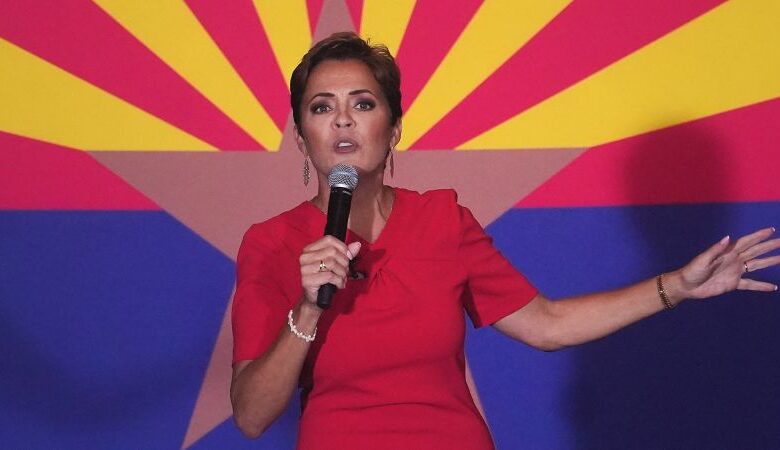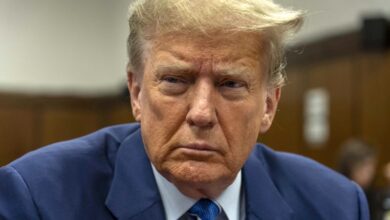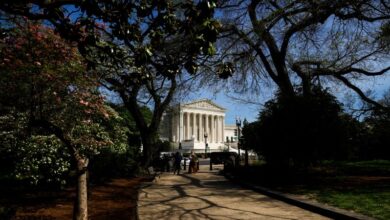Fact check: Kari Lake’s continuing false Arizona election claims

As she contemplates a run for the US Senate, Republican Kari Lake continues to make false claims about her loss in Arizona’s 2022 gubernatorial election.
Lake’s speech at a Sunday rally in Scottsdale highlighted the serial election dishonesty that has been a central feature of her campaign rhetoric. Among other things, she claimed that:
• The 2020 presidential election was stolen from former President Donald Trump. (Trump lost fair and square; his baseless “stolen” claims have been dismissed not only by the courts but by numerous officials who worked in his administration and on his campaign.)
• The 2022 Arizona gubernatorial election was stolen from her. (Lake lost by more than 17,000 votes to Democrat Katie Hobbs, in large part because people who voted for Republican candidates in other races on the ballot didn’t vote for Lake.)
• The Republicans who serve as the top election officials in Phoenix-area Maricopa County intentionally caused technical problems at Election Day voting locations to hurt her chances. (There is no evidence the problems were caused by deliberate malfeasance, as a judge found in rejecting Lake’s legal challenge.)
• Hobbs is an illegitimate “squatter” in the governor’s office. (Hobbs’ win was certified in December by outgoing Gov. Doug Ducey and outgoing state Attorney General Mark Brnovich, both Republicans, as well as Republican-appointed Arizona Supreme Court Chief Justice Robert Brutinel. Lake then lost the court challenge in which she tried to overturn her defeat.)
We won’t devote additional space to fact-checking this vague conspiracy bunk. But as Lake continues to pursue a legal appeal, we will break down a specific new claim that she framed Sunday as one of her “big bombshells.” It is nothing of the sort.
One Lake’s most dramatic claims at the rally was this: “Our experts actually testified, with 99.999% accuracy and certainty, that a minimum of 140,000 fraudulent mail-in ballots with bad signatures were counted in our election. It’s outrageous. Bogus signatures.”
Facts First: Lake’s claim is false. She exaggerated the findings of a right-wing group’s highly flawed analysis. First, the analysis did not even look at any ballots or signatures from the 2022 election. The academic who came up with the “99.999%” figure made clear that it was merely a “projection” based on the right-wing group’s conclusions about what happened in Maricopa County in the 2020 election. Second, those conclusions about 2020 are suspect: The group does not have access to all of the past signatures that Maricopa County uses in its signature verification process, so it cannot credibly say how many signatures weren’t a match. Third, even a truly mismatched signature is not itself proof that a mail-in ballot is “fraudulent” or that the signature is “bogus.” Legitimate voters’ signatures often vary over time for all kinds of benign reasons.
The election denial movement is sometimes a top-down ecosystem in which citizens come to believe the falsehood-filled rhetoric of failed candidates like Lake and Trump. But this Lake claim is an example of how the movement also works the other way, with citizens coming up with faulty findings that make their way into the candidates’ speeches.
Let’s walk through the three big problems with Lake’s claim.
The underlying analysis is flawed
Lake’s claim is based on the flawed findings of a right-wing group called We the People AZ Alliance, which, like Lake, has claimed the 2020 election was stolen from Trump.
At a hearing held last week by the Arizona state Senate’s elections committee, the group’s co-founder and chairman, Shelby Busch, testified that it got 150 “trained” people to review one quarter of the roughly 1.9 million mail-ballot envelopes from Maricopa County in 2020. Busch said the team compared the signatures on these 2020 envelopes to the signatures on voters’ registration forms to see if they matched.
Then, Busch said, the group extrapolated from its findings about this one-quarter sample to come up with a total number of signatures that, in their view, should have failed the signature verification process in 2020. The group concluded that the number was 420,987.
But there is a big problem with the group’s methodology – even if you accept that an organization with a history of election denialism did a top-notch job comparing signatures, a task that is difficult even for veteran professionals.
The problem is that We the People AZ Alliance put the signatures through a narrower verification process than the one Maricopa County itself uses. The county doesn’t only compare a voter’s signature on their new ballot envelope to the voter’s signature on their registration form. It also compares the signature on the new envelope to the voter’s signatures on other election documents that outside groups like We the People AZ Alliance don’t have.
Megan Gilbertson, communications director for the Maricopa County Elections Department, explained to CNN on Monday that the staffers who do the county’s first check of the signature on a ballot envelope are given three samples of the voter’s signature for comparison. Then, if the staffers aren’t 100% confident that the envelope signature is a match, the envelope signature is then passed on to a manager who has access to “every signature we have on file for the voter.” The past signatures can include not only voter registration forms but also signatures from various previous elections, such as those from past ballot envelopes or in-person sign-ins at voting locations.
In other words, a voter’s 2020 signature that was declared a mismatch by We the People AZ Alliance, based on a comparison to their voter registration form, might have been found to be a match by county staff based on a comparison to another document. That’s consistent with a 2020 signature verification guide from Arizona’s elections chief at the time – Hobbs – which reminded counties that “you may always look through the voter’s entire signature history” in making a match-or-not decision.
The 99.999% figure is a ‘projection,’ not an actual 2022 finding
So the We the People AZ Alliance figures for the number of signature mismatches in Maricopa County in 2020 are clearly flawed. (The group did not respond to CNN requests for comment.) But the analyst behind the “99.999%” number then used those figures as the basis for his estimate of what might have happened in the 2022 election.
Walter Daugherity, a Texas A&M University senior lecturer emeritus in computer science and engineering, told the state Senate committee that, “beginning with the 2020 election,” he has used his expertise to analyze election data. He has made baseless claims about the 2020 election in Arizona.
In this case, Daugherity said, he is discussing a “projection” of how many signature mismatches there would have been in 2022 if we assumed that there was “the same proportion” of mismatches in that election as We the People AZ Alliance determined there had been in 2020. While Daugherity’s calculations were confusing to follow – CNN’s attempts to reach him for clarification have been unsuccessful – he concluded that there is a “99.999% probability” that the number of mismatches in 2022 would again be well into the six figures, far exceeding Hobbs’ margin of victory over Lake.
The holes here should be obvious.
No “projection” based on what happened with signature verification in 2020 – a pandemic-era presidential election year with a historic crush of mail-in votes – could tell us with certainty what happened with signature verification in the midterms of 2022. And a projection is only as good as its underlying assumptions. The assumption underlying this projection is that the We the People AZ Alliance numbers for 2020 are solid. They aren’t.
Mismatched signatures are not proof of fraud
Lake claimed Sunday that experts had testified that, with “99.999%” certainty, there were a minimum of 140,000 “fraudulent” mail-in ballots in her 2022 election. But Daugherity didn’t tell the committee that the projection was about how many “fraudulent” ballots there were in 2022, just about how many mismatched signatures there might have been – and it’s critical to note that a mismatched signature is not proof that a ballot was fraudulent.
Legitimate voters’ signatures often change substantially over time, sometimes even from day to day. Former Maricopa County election official Tammy Patrick, now the CEO for programs at the National Association of Election Administrators, told CNN on Monday that, over her years of contacting voters about their mismatched signatures, she was told things like “their arm was in cast so they were signing with a different hand, they had suffered a stroke, they were signing on the dashboard of their car while driving to work.”
“Not once did I have a voter say that they had not voted, that it wasn’t their ballot,” Patrick said.
Recognizing that mismatched signatures for non-fraud reasons are commonplace, Arizona law requires counties to try to contact voters whose signatures have been deemed inconsistent, and it gives the voters up to five business days after the election to “cure,” or fix, the issue.
Gilbertson said that in the 2022 election, Maricopa County staff reached out to 14,638 voters whose signatures didn’t match; 12,838 of these ballots ended up being accepted, she said, after the voters cured the signatures.
Get Best News and Web Services here







